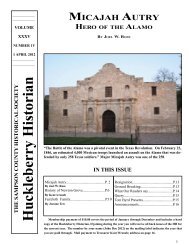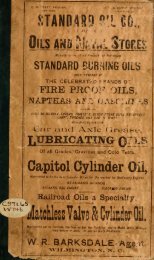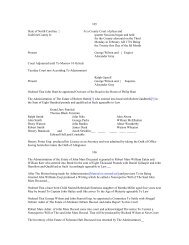11/25/07 VERSION: BEDSOLE HISTORY FROM 1673 ... - NCGenWeb
11/25/07 VERSION: BEDSOLE HISTORY FROM 1673 ... - NCGenWeb
11/25/07 VERSION: BEDSOLE HISTORY FROM 1673 ... - NCGenWeb
You also want an ePaper? Increase the reach of your titles
YUMPU automatically turns print PDFs into web optimized ePapers that Google loves.
night sounds of crying babies, chirps of crickets and small animal sounds were all<br />
that could be heard.<br />
...................................PAGE 7...........................................................................<br />
A small fire was kept burning all night in order to scare away the bigger wild animals.<br />
During the night, the mosquitos buzzed incessantly around the heads and in the<br />
ears of those trying to sleep. Some nights it rained all night and everything stayed<br />
wet, making the travelers more miserable than would otherwise be the case. With<br />
muddy trails, mosquitos, snakes, cold weather, rain, sick children, overturning<br />
wagons, lack of trails to follow, indians and things staying wet, the increased pain,<br />
misery and suffering quickly became a way of life. On any typical day, everyone on<br />
the wagon train was up at 4 a.m. and immediately set to work, repeating the jobs<br />
they had done the night before; Feeding and watering the animals, and filling all the<br />
water barrels while the women prepared breakfast, usually consisting of hoecakes,<br />
fried meat and coffee for everybody. Then the children had to be cared for and fed.<br />
After breakfast, everything had to be repacked, reloaded and lashed down on the<br />
wagons, the livestock had to be rounded up and kept together until the wagons<br />
began moving. The hunters went first. By the time the group was ready to go, most<br />
people were already tired from lack of sleep and from all the work that had been<br />
done at the beginning of the day. The night guards had most of the day to try for<br />
some sleep, but that was not easy on a loud, bumpy and very uncomfortable wagon.<br />
Finaly, with the wagon train on the move, the loose livestock were a huge problem<br />
because of the little control the settlers were able to exercise over them. Keeping<br />
them on the trail of the wagons required constant chasing, steering and caring for<br />
them all day.<br />
Along the way, they passed a few outposts and supply/trading posts which were built<br />
of logs and occupied usually by previous settlers who found living along the route to<br />
be a little easier by buying, selling and trading goods such as tools, weapons, animal<br />
hides and edibles from the Indians and other settlers, and the passing wagon trains.<br />
In the absence of money, the trade of goods was the prevalent way of doing<br />
business. These outposts also served as sources of information to all travelers<br />
concerning other settlers, indians, forts, and directions, but most importantly, they<br />
provided information on Indian troubles and trouble spots such as trees down, trail<br />
washouts, stream crossings, or landslides, or large trees across the trails ahead<br />
HOW THEY<br />
LIVED<br />
Some in the group arrived at Bladen County, Beaverdam, NC, not far from<br />
present-day Fayetteville. By that time, they had learned that the government would<br />
sell frontier land at a low cost per hundred acres, with the stipulation that the buyer<br />
would clear and plant 3 acres of the land every calendar year, for every hundred<br />
acres received, up to a limit of about 200 acres per family, depending upon the<br />
number of people in the family.










